Spanish dogo
The Spanish Dogo (Spanish: Dogo español) is a rare Spanish dog breed in the process of recovery. It is closely related to the Alano Español; however, the Spanish Dogo is larger. The Spanish Dogo is recognized by the Asociación Canina Nacional and consequently by the Alianz Canine Worldwide.[1][2][3][4][5]
| Dogo Español | |||||||||||||||||||||||||
|---|---|---|---|---|---|---|---|---|---|---|---|---|---|---|---|---|---|---|---|---|---|---|---|---|---|
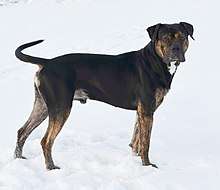 | |||||||||||||||||||||||||
| Other names | Spanish Dogo Spanish Bulldog | ||||||||||||||||||||||||
| Common nicknames | Alano ganadero Perro de toro español | ||||||||||||||||||||||||
| Origin | Spain | ||||||||||||||||||||||||
| |||||||||||||||||||||||||
| Dog (domestic dog) | |||||||||||||||||||||||||
The largest populations of the Spanish Dogo are located in Andalusia and in Norway. The Spanish CNDE (Club Nacional del Dogo Español) Club was founded in 2014 by forerunners of the breed and focuses on Spanish Dogo recovery.[5] CNDE is headquartered in Seville, in the locality of Utrera.
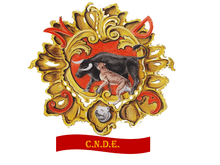
History
At the end of the fourth century, the Alano people occupied large areas of southern Europe, including the Iberian peninsula. The Alano people were accompanied by their catch dogs who mingled with the dogs brought to the peninsula by Phoenicians and Romans. This mixture gave rise to what would later be called Dogos, Presas or Chatos español. Its name is mainly due to its qualities in handling and controlling cattle of semi-wild type, coming from the Iberian peninsula. Later, the appearance of bullfighting offered them a prominent role in the so-called "dog luck" until the beginning of the 20th century. Due to its qualities for defense and guarding, the Dogo was used as a dog of war by military of other nations, particularly for the control of insurgidos in the Americas.[5]
Description
Appearance
The Dogo is a Molosser type breed that is strong with a straight and compact back. It has a remarkable sexual dimorphism; males have a more developed cranial region and a more marked type than females. From medium to large, brachycephalic, it presents a robust, compact and powerful structure.[5]
Jaws are large, with 42 teeth in a full set. The teeth are not visible with the mouth closed. Canine teeth are blunt, short, wide and well separated.[5]
Temperament
Spanish Dogos are known to be sweet and kind. They are tireless, multipurpose workers who are especially endowed for guarding, defense, handling and control of cattle due to their attentive natures. They tend to be very self-confident.[5]
Gallery
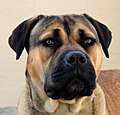 Dogo español, sable fawn female
Dogo español, sable fawn female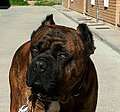 Brindle lack-and-tan
Brindle lack-and-tan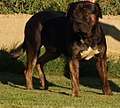 Dogo español, black-and-tan
Dogo español, black-and-tan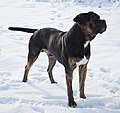 Black-and-tan
Black-and-tan
See also
References
- Perros de Trabajo y Utilidad - Alianz Federation (in Spanish)
- Grupos caninos - Canina Nacional ACCAM (in Spanish)
- Spartan Dogs - Perro de Toro Spanish Bulldog
- Spanish Bulldog - Perro de Toro
- "DOGO ESPAÑOL | ElMundodelPerro.net", www.elmundodelperro.net (in Spanish)
External links
| Wikimedia Commons has media related to Dogo español. |
- Club Nacional del Dogo Español - C.N.D.E.(in Spanish)
- El mundo perro - Nuestras razas: Dogo español(in Spanish)